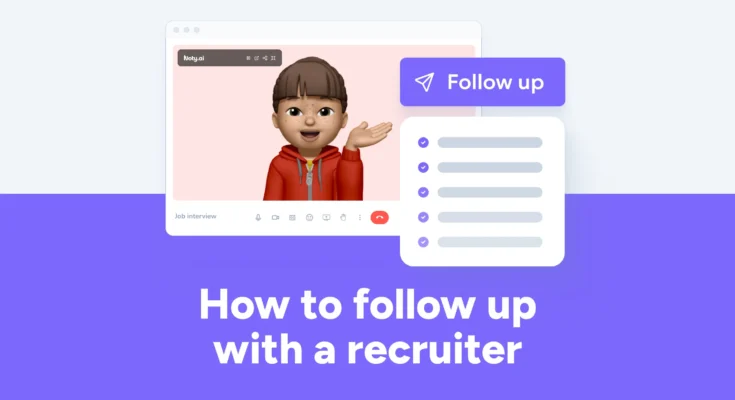Following up with a recruiter after submitting your application can significantly increase your chances of getting noticed and moving forward in the hiring process. This shows your enthusiasm and interest in this position. Here’s a step-by-step guide on how to effectively follow up with recruiters:
Be patient: give the recruiter enough time to review your application. It is usually reasonable to wait about a week after applying.
Create a polite follow-up email: Write a concise professional email to the recruiter. Begin by thanking them for the opportunity to apply and expressing your continued interest in the position. Please provide the specific job title and date of application for easy reference.
State your qualifications: Briefly remind the recruiter why you are a good candidate for the position. Highlight any relevant skills or experience that make you a strong candidate.
Request an update: Kindly ask about the status of your application and if there is any additional information you need to provide. Reiterate your interest: End the email by reiterating your enthusiasm for the site and your desire to hear back.
Follow up again if needed: If you don’t hear back after the first follow-up, you can send another polite email after a week or so. If you still haven’t heard back, it’s best to move on and focus on other options.
Remember that it is important to be professional and courteous in subsequent communications.
Timing of Follow-Up
General timeframe for sending a follow-up after submitting an application
The timing of your follow-up is crucial in making a positive impression. Generally, it’s advisable to wait at least one to two weeks after submitting your application before sending a follow-up. This allows the recruiter sufficient time to review applications and assess potential candidates. Sending your follow-up too soon might be perceived as impatient, while waiting too long might cause you to be overlooked. Striking the right balance showcases your eagerness without appearing overly aggressive.
Considerations for timing based on the specific job application process
Different organizations may have varying timelines for reviewing applications. Research the company’s hiring process to determine whether they have specified a timeframe for candidate evaluations. Tailor your follow-up accordingly, aligning it with their internal schedule. If the job posting indicates a specific closing date, you may want to wait until after that date has passed before following up, allowing the recruiter time to sift through applications and make initial assessments.
Avoiding excessive or too frequent follow-ups
While a well-timed follow-up is essential, bombarding the recruiter with excessive or too frequent communications can have the opposite effect. Respect the recruiter’s workload and prioritize quality over quantity. If you haven’t received a response after the initial follow-up, exercise patience and consider waiting another week or two before sending a polite reminder. Striking the right balance between persistence and patience is key.
Crafting an Effective Follow-Up Email
Personalizing the email to the specific recruiter
Personalization is a crucial element in crafting an effective follow-up email. Address the recruiter by their name and reference specific details from your previous interactions or the job posting. This demonstrates your attention to detail and genuine interest in the position. Avoid generic and mass-produced follow-up templates; instead, tailor your message to align with the company’s culture and values.
Expressing continued interest in the position
Reiterate your enthusiasm for the position in your follow-up. Emphasize why you are particularly interested in the role and how your skills align with the company’s needs. This not only reinforces your commitment but also provides the recruiter with a clear reminder of your qualifications. Be specific about what attracted you to the position and why you believe you are an excellent fit.
Briefly summarizing qualifications and reiterating enthusiasm for the opportunity
In the body of your follow-up email, concisely summarize your key qualifications. Highlight specific experiences, skills, or achievements that make you a standout candidate. Use this opportunity to reinforce how your background aligns with the requirements of the position. Additionally, restate your enthusiasm for the opportunity and convey your eagerness to contribute to the organization’s success.
Including a clear and concise subject line
The subject line of your follow-up email plays a crucial role in capturing the recruiter’s attention. Keep it clear, concise, and relevant. Mentioning your name and the position you applied for can help the recruiter quickly identify your email among the many they receive. Avoid using vague or generic subject lines that may be overlooked in a busy inbox.
Ensuring proper grammar, spelling, and professional tone
An effective follow-up email should be meticulously proofread to ensure proper grammar and spelling. Typos and errors can create a negative impression and undermine your professionalism. Use a formal and respectful tone throughout the email. Avoid overly casual language or excessive exclamation points. The goal is to convey competence and professionalism, reinforcing your suitability for the role.
Polite Persistence
Sending a polite reminder if there’s no response after the initial follow-up
In some cases, recruiters may be inundated with emails and may unintentionally overlook your initial follow-up. If you haven’t received a response after a reasonable period, it’s acceptable to send a polite reminder. Craft your reminder with the same level of professionalism as your initial follow-up, expressing your understanding of the recruiter’s workload and reiterating your interest in the position.
Highlighting relevant achievements or updates since the application submission
If you’ve achieved significant milestones or gained relevant experience since submitting your application, use your follow-up as an opportunity to share these updates. This not only showcases your continuous professional development but also reinforces your commitment to the position. Frame these achievements in a way that directly relates to the requirements of the job.
Emphasizing willingness to provide any additional information
Reassure the recruiter of your openness to providing any additional information they may require. This demonstrates your transparency and eagerness to facilitate the recruitment process. Include a brief mention of your availability for an interview or any assessments they may deem necessary. By proactively addressing potential information gaps, you position yourself as a cooperative and engaged candidate.
Utilizing Other Communication Channels
Exploring alternative methods of follow-up (phone calls, LinkedIn messages, etc.)
While email is a common medium for follow-ups, exploring alternative communication channels can help you stand out. If the job posting includes a contact number, consider placing a brief and polite follow-up call. Alternatively, sending a personalized LinkedIn message can be effective, especially if the recruiter is active on the platform. Choose the communication channel that aligns with the company culture and the recruiter’s preferred mode of contact.
Adhering to professional etiquette when using different communication channels
Regardless of the communication channel you choose, adhere to professional etiquette. When making a phone call, introduce yourself, state the purpose of your call, and be prepared to leave a voicemail if necessary. In a LinkedIn message, maintain a formal tone, address the recruiter by name, and reference your application. Avoid overly persistent or intrusive behavior, ensuring that your follow-up is perceived as professional and respectful.
Handling Non-Responsive Situations
Waiting for a reasonable period before following up again
After sending a follow-up, it’s crucial to exercise patience before considering additional follow-ups. Recruiters often have busy schedules, and their timelines for reviewing applications may vary. Wait for a reasonable period, typically one to two weeks, before sending a second follow-up. This allows the recruiter ample time to address inquiries and assess candidate profiles.
Knowing when and how to gracefully move on if there is no response
If multiple follow-ups yield no response, it may be an indication that the position has been filled or that the organization has chosen another candidate. While persistence is commendable, it’s equally important to know when to gracefully move on. Keep monitoring other job opportunities, and if the silence persists, redirect your focus to new prospects. Maintaining a positive and professional attitude, even in non-responsive situations, contributes to a favorable personal brand.
Thank You Follow-Up After an Interview
Expressing gratitude for the opportunity to interview
Following an interview, expressing gratitude is not only courteous but also reinforces your professionalism. Begin your thank-you email by expressing sincere appreciation for the opportunity to interview. This sets a positive tone and reflects your enthusiasm for the position.
Reiterating interest and enthusiasm for the position
Reaffirm your interest in the position and the organization. Mention specific aspects of the interview or company culture that resonated with you. This not only reinforces your commitment but also helps the recruiter remember your genuine enthusiasm.
Inquiring about the expected timeline for a decision
Conclude your thank-you email by expressing understanding of the time required for the decision-making process. Politely inquire about the expected timeline for a decision, demonstrating your ongoing interest while allowing the recruiter the space needed for their deliberations. This information also helps you manage your expectations and plan for potential future interactions.
Additional Tips and Best Practices
Keeping follow-up communications concise and focused
Effective follow-up communications are concise and focused. Recruiters often have limited time, so avoid lengthy emails or messages. Stick to the key points, such as expressing continued interest, summarizing qualifications, and inquiring about the next steps. Clear and concise communication enhances the likelihood that your message will be read and understood.
Customizing follow-up strategies based on the specific organization and recruiter
Recognize that different organizations and recruiters may have unique preferences for communication. Tailor your follow-up strategy based on the company’s culture, the recruiter’s communication style, and any specific instructions provided in the job posting. Customizing your approach demonstrates your adaptability and attention to detail.
Being patient and understanding of the recruiter’s workload
Patience is a virtue when following up with recruiters. Understand that recruiters manage multiple responsibilities, including reviewing applications, conducting interviews, and coordinating with hiring managers. Avoid the temptation to rush the process and be patient while waiting for responses. This patience reflects positively on your professionalism and respect for the recruiter’s workload.
Also Read: How long does it take to get an associate degree?
Conclusion
In conclusion, effective follow-up with a recruiter is a strategic and courteous approach to enhance your visibility and reinforce your candidacy. By following the outlined guidelines, you can navigate the follow-up process with professionalism and increase the likelihood of a positive response.
Encouraging a proactive and professional approach to follow-ups with recruiters
Encourage a proactive mindset in your approach to follow-ups with recruiters. Take the initiative to communicate your continued interest, qualifications, and enthusiasm for the position. By maintaining a professional demeanor and adapting your strategy to the specific context, you position yourself as a candidate who is not only qualified but also attentive and dedicated throughout the recruitment process.




